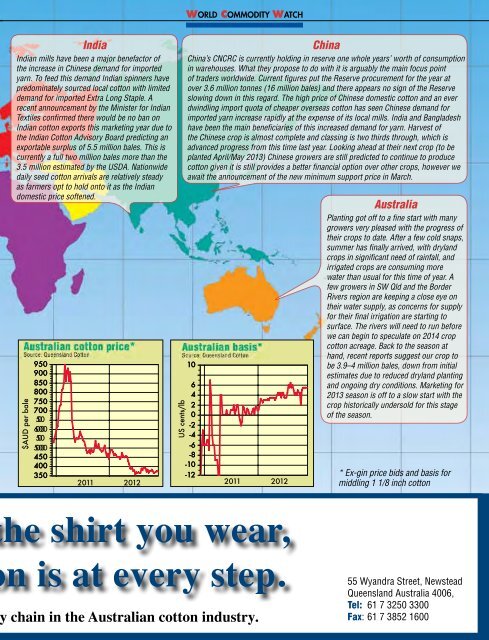cotton - Greenmount Press
cotton - Greenmount Press
cotton - Greenmount Press
Create successful ePaper yourself
Turn your PDF publications into a flip-book with our unique Google optimized e-Paper software.
World CoMModity Watch<br />
India<br />
Indian mills have been a major benefactor of<br />
the increase in Chinese demand for imported<br />
yarn. To feed this demand Indian spinners have<br />
predominately sourced local <strong>cotton</strong> with limited<br />
demand for imported Extra Long Staple. A<br />
recent announcement by the Minister for Indian<br />
Textiles confirmed there would be no ban on<br />
Indian <strong>cotton</strong> exports this marketing year due to<br />
the Indian Cotton Advisory Board predicting an<br />
exportable surplus of 5.5 million bales. This is<br />
currently a full two million bales more than the<br />
3.5 million estimated by the USDA. Nationwide<br />
daily seed <strong>cotton</strong> arrivals are relatively steady<br />
as farmers opt to hold onto it as the Indian<br />
domestic price softened.<br />
<br />
<br />
<br />
<br />
<br />
<br />
<br />
<br />
<br />
<br />
<br />
<br />
<br />
<br />
<br />
<br />
China<br />
China’s CNCRC is currently holding in reserve one whole years’ worth of consumption<br />
in warehouses. What they propose to do with it is arguably the main focus point<br />
of traders worldwide. Current figures put the Reserve procurement for the year at<br />
over 3.6 million tonnes (16 million bales) and there appears no sign of the Reserve<br />
slowing down in this regard. The high price of Chinese domestic <strong>cotton</strong> and an ever<br />
dwindling import quota of cheaper overseas <strong>cotton</strong> has seen Chinese demand for<br />
imported yarn increase rapidly at the expense of its local mills. India and Bangladesh<br />
have been the main beneficiaries of this increased demand for yarn. Harvest of<br />
the Chinese crop is almost complete and classing is two thirds through, which is<br />
advanced progress from this time last year. Looking ahead at their next crop (to be<br />
planted April/May 2013) Chinese growers are still predicted to continue to produce<br />
<strong>cotton</strong> given it is still provides a better financial option over other crops, however we<br />
await the announcement of the new minimum support price in March.<br />
<br />
<br />
<br />
<br />
<br />
<br />
<br />
<br />
<br />
<br />
<br />
<br />
Australia<br />
Planting got off to a fine start with many<br />
growers very pleased with the progress of<br />
their crops to date. After a few cold snaps,<br />
summer has finally arrived, with dryland<br />
crops in significant need of rainfall, and<br />
irrigated crops are consuming more<br />
water than usual for this time of year. A<br />
few growers in SW Qld and the Border<br />
Rivers region are keeping a close eye on<br />
their water supply, as concerns for supply<br />
for their final irrigation are starting to<br />
surface. The rivers will need to run before<br />
we can begin to speculate on 2014 crop<br />
<strong>cotton</strong> acreage. Back to the season at<br />
hand, recent reports suggest our crop to<br />
be 3.9–4 million bales, down from initial<br />
estimates due to reduced dryland planting<br />
and ongoing dry conditions. Marketing for<br />
2013 season is off to a slow start with the<br />
crop historically undersold for this stage<br />
of the season.<br />
* Ex-gin price bids and basis for<br />
middling 1 1/8 inch <strong>cotton</strong><br />
he shirt you wear,<br />
n is at every step.<br />
chain in the Australian <strong>cotton</strong> industry.<br />
55 Wyandra Street, Newstead<br />
Queensland Australia 4006,<br />
Tel: 61 7 3250 3300<br />
Fax: 61 7 3852 1600

















